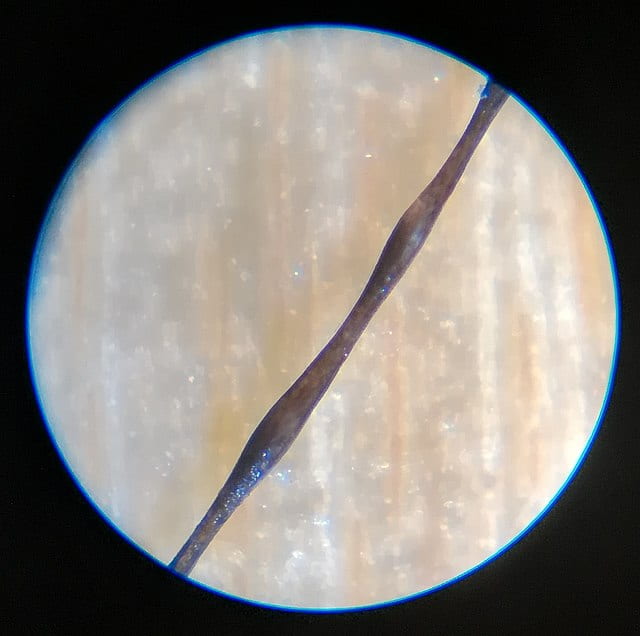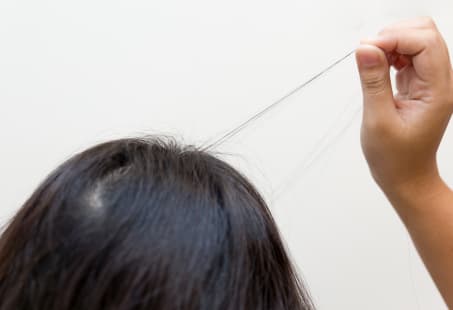Monilethrix is a rare disorder characterised by the presence of beaded hair shafts. It essentially consists of “nodes” with normal hair thickness. However, these are punctuated by narrow segments in between.
But because of the fragility of the hair between the nodes, it ends up breaking quite easily. It can also cause varying degrees of alopecia – very mild or complete loss of hair.
Those who have this condition might not even be able to grow their hair too long, not ever needing a haircut. Although this condition cannot be cured, curiously enough, there have been cases of remission (when monilethrix’s symptoms disappear).
But if you have this condition, there are some treatments that might be able to help you. Also, there are some things you need to avoid to not exacerbate your hair loss.
What Is Monilethrix?
Monilethrix, also known as beaded hair, is when the hair shaft is deformed in a way that it starts to resemble a beaded necklace. That’s how this condition got its name as well – “monile,” meaning necklace, and “thrix,” hair. And the hair, in this case, can be fragile enough to break while still inside the scalp.

Monilethrix is not just limited to the scalp; it can also affect hair on the face and body, including eyelashes, eyebrows, armpits, pubic area, arms and legs.
When it’s mild, it may only occur on the back/nape of the neck. However, in more severe cases, it can engulf the entire scalp and extend to the body.
While it’s an inherited condition, it’s more likely that there’s nothing with your hair when you’re born. But within a few months, it will start to show, and keep in mind that this condition lasts a lifetime.
Is Monilethrix Contagious?
Monilethrix is not a contagious disease since it’s not caused by infectious agents (microorganisms like viruses and bacteria).
It’s believed to occur due to genetic mutations that are passed down to a child from their parent(s). So, it’s an inherited, genetic or congenital condition, not an contagious one.
What Are The Symptoms Of Monilethrix?
You have have the following symptoms if you have monilethrix:
- Short, dry, and lustreless hair
- Brittle/easily breakable hair
- Short (1-2 cm) hair
- Sparse hair
- Rough-looking scalp
- Papules (or lesions) around hair follicles with gray or brown scales (perifollicular hyperkeratosis)

What Causes Monilethrix?
Monilethrix is caused by abnormalities in some genes, which are then passed on to the child. Usually, just a single copy of the gene (from one parent) is enough to cause this condition (it’s referred to as an autosomal dominant trait).
Because of mutations in the genes that provide instructions for the development of keratin – a major protein found in hair – the hair’s unable to form normally.
Keep in mind that keratin plays an important role in the health and strength of your hair. But its abnormalities end up making the hair weak and fragile.
Other than that, monilethrix can also be inherited in what’s known as an “autosomal recessive” pattern. In this, the child needs to get both copies of the mutated gene from both the parents to develop monilethrix.
This rarely happens, but when it does, it has to do with a type of gene that affects another hair protein called desmoglein – it also ensures the strength of the hair and even helps with communication between cells.
How Do You Treat Monilethrix?
Different medications have been used for the treatment of monilethrix. Most commonly, you’ll hear about the use of minoxidil. There are case studies that have shown an improvement in hair density, length, and strength with the use of minoxidil on monilethrix-affected hair.
You might be given a topical solution for it. However, since rubbing it in can traumatise the already fragile hair and make it fall (or increase breakability due to dryness), it’s also possible that your doctor prescribes a low-dose oral minoxidil instead.
According to Medscape, however, some of the other drugs that have been used to treat it include:
- Vitamins
- Retinoids
- Birth control pill
- Steroids
- Radiation therapy
Although researchers also highlight the importance of avoiding doing anything traumatic to the scalp, which can include:
- Bleaching
- Dyeing
- High heat exposure (including sunlight)
- Aggressive combing
- Glues from hair accessories (like wigs)
In any case, you must consult a board-certified professional for an effective treatment plan.
Is Monilethrix Curable?
Monilethrix is not curable. In fact, it’s considered a lifelong disease. You’ll quite likely have fragile hair with alopecia for your entire life.
However, there have been reports of this condition improving itself all of a sudden, especially in puberty and pregnancy. It’s possible for you to even completely recover from this with your hair starting to grow normally.
Conclusion
Monilethrix is an incurable hair shaft disorder that makes the hair look like a beaded necklace on closeup. Because it makes the hair very fragile and easily breakable, you might only have sparse hair on your scalp.
Of course, this condition can be very distressing to the patient because of the aesthetic problems it causes. While there’s no standard treatment for this condition, some medications are used to improve hair growth.
That might help you, or this condition might resolve on its own. But if you’re experiencing hair loss, make sure to get diagnosed by a medical professional. They’ll prepare an effective treatment plan for you accordingly.
Reviewed and Approved by Trichologist Yaprak Yazan


